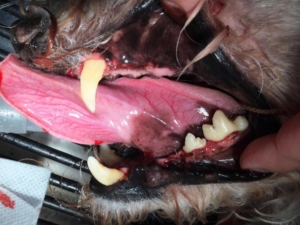How to Detect Periodontal Disease: Sparky’s Story


Left: Before veterinary dentistry. Right: After veterinary dentistry.
Sparky is a 10 yr old Schnauzer, whose owner recently noticed discharge coming from an open wound on the left side of his face. Realizing that it could be something serious, an appointment was made to have it checked out at Seminole Blvd Animal Hospital.
After a thorough physical exam by Dr. Clark, Sparky was diagnosed with a tooth root abscess and was suffering from Stage IV periodontal disease. Sparky’s treatment plan involved going under anesthesia to perform an Oral Health Procedure (Dental) which involved oral surgery to remove the severely damaged teeth.
Before undergoing any surgical procedure, it is important to run blood work to assess the patient’s ability to process the anesthesia. Once this was done and it showed no abnormalities, Sparky was cleared for surgery.
During the procedure, all teeth were scaled and polished with extensive cleaning performed below the gum line. Full mouth dental X-rays were also performed, which showed severe horizontal bone loss under several teeth, along with severe tartar buildup and gingival recession. Sparky was already missing some teeth as a result of periodontal disease and needed a further 16 teeth extracted.
As you know a dog not only uses his mouth to eat, but also to retrieve and carry in a similar way that we use our hands and with this constant use comes more risk of problems with the mouth and teeth. Dogs and cats cannot tell us when something hurts and can be masters when it comes to hiding pain. Very often we don’t know if there is anything wrong in the mouth until the pet stops eating or shows discomfort by pawing at their face or as in Sparky’s case, something physical shows up. This is why it is important to make a habit of ‘flipping the lip’ and checking for abnormalities. This is done routinely at each doctors visit, but it would help if owners also did this on a regular basis at home so that they can become aware of a problem such as a broken tooth or gum recession, before it gets too severe.
Sparky recovered well from his procedure and was a lot more comfortable after his extractions which showed through in his happy demeanor after returning home. Once healed he continued eating his regular diet like a champ! We always say pets are far better off with no teeth and no pain than with teeth that constantly cause discomfort.
What is Periodontal Disease?
Periodontal disease happens when plaque, a colorless film containing large amounts of bacteria is left unchecked, builds up, creating an infection, destroying gum tissue, resulting in the loss of the tissue and bone that support the teeth. There are four stages of periodontal disease:
 All pets are at risk for developing problems with their teeth, and if your pet displays any of the warning signs listed below, serious periodontal disease may be present.
All pets are at risk for developing problems with their teeth, and if your pet displays any of the warning signs listed below, serious periodontal disease may be present.
• Bad Breath
• Yellow-brown crust on teeth
• Tooth loss
• Change in behavior
• Abnormal drooling
• Bleeding gums
• Change of chewing or eating habits
If you ignore the condition of your pet’s mouth, this can lead to periodontal disease, tooth loss, and could also lead to other serious health problems, such as heart, liver, or kidney failure.
There are several things you can be doing at home to protect your pet from this disease:
• Be aware of the warning signs of periodontal disease.
• Inspect your pet’s mouth regularly.
• Brushing your pet’s teeth will help control plaque buildup. To begin brushing it is best to introduce the practice gradually and early; training may take several days or weeks.
• Never brush your pet’s teeth with toothpaste designed for people. Use a paste specifically made for animals and a soft bristle toothbrush.
• If brushing your pet’s teeth is difficult, you could use dental chews like OraVet.
Periodontal disease is more common as pets grow older. That is why it is important to have regular, professional care visits with your veterinarian and effective daily home care from you can help keep your pet’s mouth healthy.
